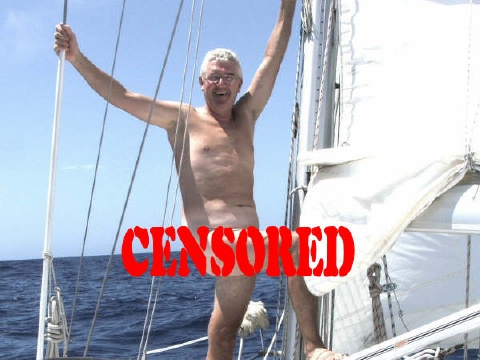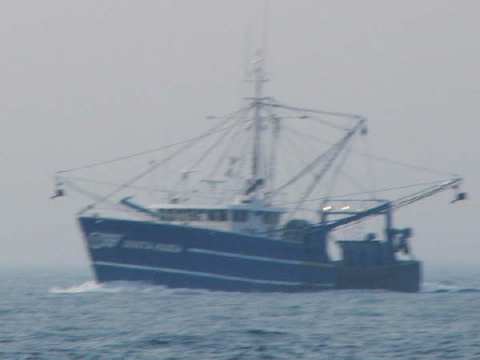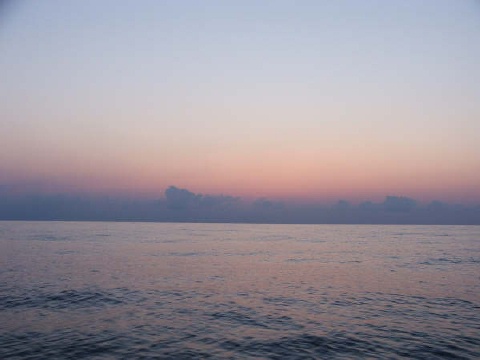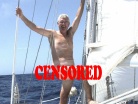
Who says the great white whale is in danger of extinction?
Living the Dream
America or bust!
Having resolved that we were heading for Plymouth, Massachusetts, we planned to leave early on 15 May 2007 and complete a good day’s sail before nightfall, so that we could settle into the ocean watch system again. This was not, however, as planned, because on the day before we left, Siobhán caught the ferry to Tortola to do some last minute shopping. She took her passport and all the money with her, so that when I went to clear out through the customs and immigration, I could not do so. Her ferry arrived back in Jost van Dyke ten minutes before the customs office closed, so by the time I had rushed over to the terminal and picked up Siobhán, it was too late. So I had to clear out on the 15th. The customs didn’t arrive until 0830 hours so this meant that instead of leaving at 0700 as planned, we left at 1115. One day we will be on time!
I know that it takes some couples a few days to settle back into the ocean swell, eating and sleeping routine, but we were straight back into it, sailing away from the British Virgin Islands (BVI) with full main and lightweight genoa (LWG) on a run with a moderate southerly force 4 breeze.
As we cleared the islands, this changed to a beam reach in a fresh force 5 easterly breeze and we reefed down with Hal the hydrovane working very efficiently. During the first night the wind rose to above 21 knots, so we reefed down with two reefs and a half working jib for comfort. We sailed through the night comfortably with three-hour watches. By 0900 the following morning the wind had risen and blew between 24 and 30 knots until noon when it moderated to 20 knots. Later in the early evening, we ran off due to continuous strong squalls. Siobhán spoke to a large ship which was creeping up on our starboard side and the Spanish sounding watch confirmed that he would pass us on our starboard side, but within 30 minutes we had to alter course as he cut right across our course in front of us.
During that night and through to the next day, 17 May, we were subjected to force 6 (25-knot winds), with thunder and lightening brightening up the sky for most of the night. At 0920, Siobhán logged “Sky grey, sea purple grey, food good, one dead flying fish in the cockpit. Smelled him before I saw him.” We threw him overboard.
I remarked at 0815, “Two days out and nothing changes — force 6-7, crossing large swell, grey and overcast and rain. I want the Caribbean! By 1115 on the second day we had covered 288.5 nautical miles (NM) in 48 hours at an average of 6 knots, which cheered us. Of course, one then starts to calculate how long the voyage is going to take, but reality soon pours sour cream over one’s optimistic plans, but not immediately. By noon the next day we had covered 420 NM, and the wind had dropped from 25-28 knots to 16-17.
Good progress
At 1800 on the 18th, we were running on main alone and the engine to charge the service batteries, as the genoa could not make up its mind, or rather the wind would not let it. The rain had stopped and the cockpit was dry for the first time in 36 hours. The sky was completely grey and Siobhán thought it looks thundery. Still, we had by then notched up 450 miles which left only 1000 to go.
During the night we were running the engine to charge the service batteries, which we need to keep fully charged as they keep the fridge, gas and water working and we heard a different noise coming from the engine compartment. Upon examination, I found that the metal alternator adjuster plate had snapped in two. I then charged my battery drills and spent the next hour or so in the forecastle workshop fabricating a new one out of some spare L-shape plate I had, while Siobhán was on watch on deck in the force 6 winds we were experiencing at the time. Not a pleasant experience concentrating on the job at hand in the swell, but the plate is still working, so it was worthwhile and satisfying.
At 0300 on the 19th, Siobhán logged “Dry night, but overcast. Saw stars about 1 hour ago. Sky cleared for 40 minutes but now cloudy again. Very dark night. No moon. Boat speeding along between 6.5 and 7 knots.” Under sail.

New England
fishing boat
At 0400 I logged, “Furled working jib as wind has veered to southerly at 0400.” At 0900 I logged, “Gybed the main lightweight genoa and changed course to 350º for more comfortable sail. Beautifully warm sunny morning for busying around doing little jobs. Drying clothes and wet weather gear on deck.
1000, “Saw pink object in the water to starboard. When we investigated it was a workman’s hard hat floating along.” 1100, “Large ship passed our stern about one mile off going west.”
I summarised the day by saying, “A calm day with no high winds. 9-12 knots, 4-5 knots boat speed, but still moving north slowly. Spent some time learning verses of folk tunes — relaxing. I now have a repertoire of some six songs, in case I am ambushed again at some impromptu folk singers’ gathering.”
At 1830 that day, we were running the engine to charge the bank of four service batteries (we really must get solar panels to charge those) when the engine ran down and stopped suddenly. I immediately switched off and went below, checked the fuel tap that it was on and checked that the water filters were clear of obstructions. I removed a large piece of seaweed from the engine intake seacock filter, tried the engine again and she fired first time. Phew, thank goodness it was that simple, but you never know when that will happen. I had only cleaned them two days before.
“Trimmed sails for beam reach sailing, still with full main and lightweight genoa. A quiet and calm night. Off to sleep at 0300, leaving Siobhán on watch.” At 0610 after I had relieved Siobhán I wrote, “Full main and lightweight genoa, calm sea, blue sky. Siobhán asleep, Cool breeze 8-10 knots.” This was the first mention of the air temperature getting colder and as we headed north for the “American summer”, we gradually put more clothes on.
At 0700 we were becalmed on a glassy sea, which was as flat as a pancake.
Time to put some clothes on
At 0840 I wrote “Furled genoa and engine on to charge batteries. An absolutely splendid morning but temperature has dropped from 85º in the Caribbean to what felt like 45º. Siobhán’s shower was distinctly cold. Brrh!”
On 22 May, at 0145 hours, Siobhán wrote, “No wind. Furled genoa and changed heading to 014º M. Beautifully calm, starry night, with gentle phosporescent waves spreading from the bow. Shooting stars, but no meteorites crashing to the horizon in a green haze, like two nights ago. Weather forecast shows that we are in a high pressure area, which is due to dissipate within 24 hours. We saw a short finned pilot whale about 0530, which was going east at a leisurely pace.
Later I wrote, “Onto port tack — full main and LWG. Wind has backed to NW, but still only minimal. In the calms one sees some interesting items, but over the last two days, I have seen dozens of what looked like crumpled plastic coffee cups. I think I have been seeing egg sacs of some marine animal. We really must purchase a large net to pick up these samples and then we could tell if it was organic or man made. For days we had also seen miles of batches of blooming seaweed clusters, obviously moving to their new breeding ground.

At 0700 we were becalmed
on a glassy sea
We switched onto starboard tack with the full main and lightweight genoa and headed north-west in search of the southerlies on the west of the high pressure area. This move was one of a series of changes we made in an attempt to find southerlies, but all to no avail.
At 1440, the wind piped up to 17 knots and looked like rising so we reefed down and substituted the working jib for the LWG. During the next few hours we crossed the paths of several yachts which were in the Charleston to Bermuda race and spoke to them on radio. It was great to hear their southern US accents.
We were getting frustrated by our inability to head where we wanted, but on the 24th the wind had died and with 9 knots of easterly we were able to head north. We had a quiet sea, blue sky and streets of fluffy clouds to herald the full blown 1031 isobars of the high. It felt good to be alive, slipping through the seas at 6.5 knots. I logged, “I am looking forward to the midday fix to see where we are as yesterday was a great day with over 150 miles covered but in a north-westerly direction. We discussed heading for New York instead of Cape Cod, but decided to see where the favourable winds would take us. Isn’t it great when you can get 6.6 knots boat speed out of 6.6 knots of wind. This morning we have a happy medium — enough wind to give us a fair boat speed, but not too much to make the seas lumpy — idyllic really.” We had covered 1164 miles in nine days, at an average of 129 miles per day, with which we were delighted.
On 25 June at 1130 hours, I recorded, “Swell abated and wind down from 25 knots to 17/18. Unfurled the working jib. Three dolphins are playing around the bow — great omen — green water sailing again under a completely blue dome of heaven. Living within a high for three days. We’re travelling north, while it is travelling south.”
Later, Siobhán cut my hair, as she has since we have been sailing, as well as any hairdresser. We spoke on the radio to a German sailing boat, Lotta, which crossed our path en route to New York.
The following day, 26th, we had 130 miles to go, our speed was 6 knots. It was a very cold watch at night and we both took turns sitting in the companionway, well wrapped up with a hot water bottle stuffed inside our wet weather gear. Somewhat different from 11 days previously in the Caribbean.
On the same day at 1700 hours, I reported, “We have 57 miles to go but we’re becalmed again. Passed fishing buoys in 68 metres. It gave a new meaning to deep sea fishing. A large merchant ship passed us about three miles astern, but it was so still we could hear his engines. We were making only 2.8 knots speed over the ground. After three days of no clouds, high cirrus clouds are drifting over the sun and I will be forced to put some clothes on. Siobhán is sleeping peacefully below.”
At 1845, I spoke to a large New England fishing boat, “Santa Maria” and asked about the spread of nets from there to the coast. He reassured me there would be none to worry about. He said the buoys we had seen were not his as he was bottom trawling.
Later that night we switched the engine on, furled the genoa and centred the main, as there was no wind again.
Our computer navigator Maptech and Garmin were working together and I had solved the contact point problem in the GPS. We had purchased a new computer package from Maptech, which covers all the coastline of the USA, inland waterways (including the intracoastal waterway (ICW), the great lakes and large rivers. It was more economical than buying all the detailed charts of the areas we will be visiting or may be visiting in the future. We had not however used Maptech since Portugal as we had charts for Madeira, Canaries and Caribbean, so it was a matter of configuring Maptech and Garmin again.
Approaching the USA we started using it and it has been invaluable ever since. We used the computer and Maptech to navigate into Newport, Rhode Island. We contacted the harbourmaster of Newport, but he was unable to assist us with a mooring, so providentially, we turned towards Jamestown, the island opposite Newport, the so-called “centre of US sailing.”
At 1000 hours on 27 May 2007, 12 days after setting sail from Jost van Dyke in the British Virgin Islands, we tied up in Conanicut Marina, Jamestown, having completed 1478 miles in 12 days (an average of 123 miles per day). For those who like to know what broke or went wrong, sorry to disappoint you but we had a very enjoyable sail. Fate had wafted us towards Rhode Island and likewise to Conanicut Marina, where we received a warm, pleasant and efficient reception. It was Memorial Day weekend and there was a holiday festive feeling about the town behind the marina. Looking back, we both agree that we could not have found a more hospitable landfall. America seemed to welcome us with open arms.
In our next update we will continue our report on the journey along America’s coastline.
Lots of love from Siobhán and Lawry
27 June 2007
Go to the ... Archives
... or see the photos from this report
